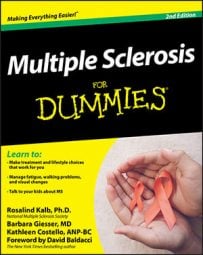Children have a difficult time understanding symptoms they can’t see, such as those you might have with multiple sclerosis (MS). They can see that you trip or lose your balance and need a cane or scooter to help you walk. And they can see (and probably think that it’s funny) that you drop things a lot.
But kids have a much harder time getting a handle on fatigue, cognitive, or vision problems or other invisible symptom. For example:
Children know that when they’re tired, they can go to sleep and feel much better when they wake up. But it’s difficult for them to understand that sometimes you feel just as tired when you wake up as you did when you went to sleep. Older kids, in particular, may think that you aren’t interested in doing stuff, or that you aren’t trying very hard (this situation is when open communication is particularly helpful).
Children know that many people wear glasses. So, they may find it difficult to understand why your vision problems can’t be fixed with a new pair of glasses or contact lenses.
Kids understand pain — something hurts until it’s better, and then the pain goes away. Chronic pain, however, is likely to be much more difficult for them to comprehend.
Problems with thinking and memory are particularly difficult for children to understand and easy for them to misinterpret. They may think that you aren’t interested enough to pay attention to what they’re saying, or that you’re “getting dumb.”
You can help your kids understand the challenges you’re experiencing by involving them in some of the strategies that you use to compensate for your cognitive problems.
You may want to let your kids “try on” some of your physical symptoms. Obviously, these “try-ons” don’t give the full picture, but they offer kids a hint of what some MS symptoms can feel like. Here’s how to do it:
Let your kids wear some light ankle weights while they walk around for a little while. Doing so can give them a sense of what it feels like when your legs and ankles feel tired and weak.
Put an elastic bandage around their knees or elbows so they can feel what spasticity (stiffness) feels like.
Place an elastic bandage around your kids’ chests or tummies. This bandage can give them a pretty good imitation of the uncomfortable sensory symptom that feels like an “MS hug.”
Smear a little petroleum jelly on a pair of sunglasses to demonstrate what blurry vision looks like.
Stick a little square of cellophane tape in the center of each eyeglass to show what patchy vision can look like.
Have your kids try to button a shirt, pick up pennies, or unwrap a piece of hard candy while wearing rubber kitchen gloves. Doing so can help them see how numbness in your hands can make it tough for you to do things.
Tell you kids to spin in a circle until they’re dizzy. When they’re dizzy, tell them that is what vertigo can feel like for you.
Mood changes are more difficult to demonstrate, but they’re just as important to explain. Kids definitely know when you’re down or cranky. And they’re quick to assume that they’re the cause — particularly if you take your moods out on them. So, it’s a good idea to talk about your moodiness reassure them that your moods aren’t because of them.

